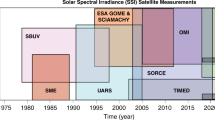Abstract
Appleton1 and Hey2 have directed attention to the fact that radio-frequency energy, with some of the characteristics of random ‘noise’, is emitted with greatly increased intensity from the sun under the conditions of violent disturbance associated with a large sunspot. These observations were confined mainly to the region of frequencies near 60 Mc./s.
This is a preview of subscription content, access via your institution
Access options
Subscribe to this journal
Receive 51 print issues and online access
$199.00 per year
only $3.90 per issue
Buy this article
- Purchase on Springer Link
- Instant access to full article PDF
Prices may be subject to local taxes which are calculated during checkout
Similar content being viewed by others
References
Appleton, Nature, 156, 534, (1945).
Hey, Nature, 157, 47, (1946).
Pawsey, Payne-Scott, and McCready, Nature, 157, 158, (1946).
Author information
Authors and Affiliations
Rights and permissions
About this article
Cite this article
RYLE, M., VONBERG, D. Solar Radiation on 175 Mc./s. Nature 158, 339–340 (1946). https://doi.org/10.1038/158339b0
Issue Date:
DOI: https://doi.org/10.1038/158339b0
This article is cited by
-
Radio Imaging With SWAN
Resonance (2022)
-
A space-based decametric wavelength radio telescope concept
Experimental Astronomy (2018)
-
Radio observations of active galactic nuclei with mm-VLBI
The Astronomy and Astrophysics Review (2017)
Comments
By submitting a comment you agree to abide by our Terms and Community Guidelines. If you find something abusive or that does not comply with our terms or guidelines please flag it as inappropriate.



